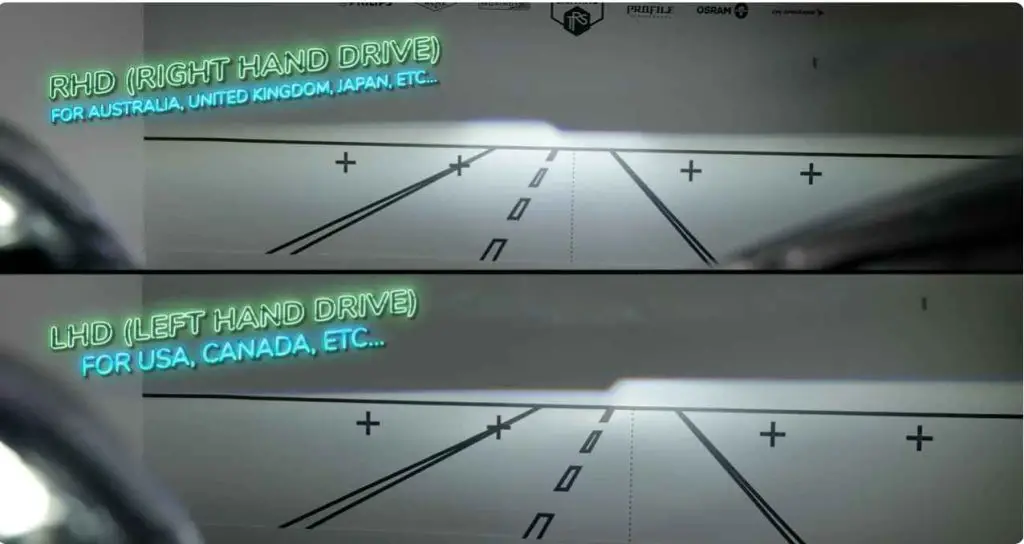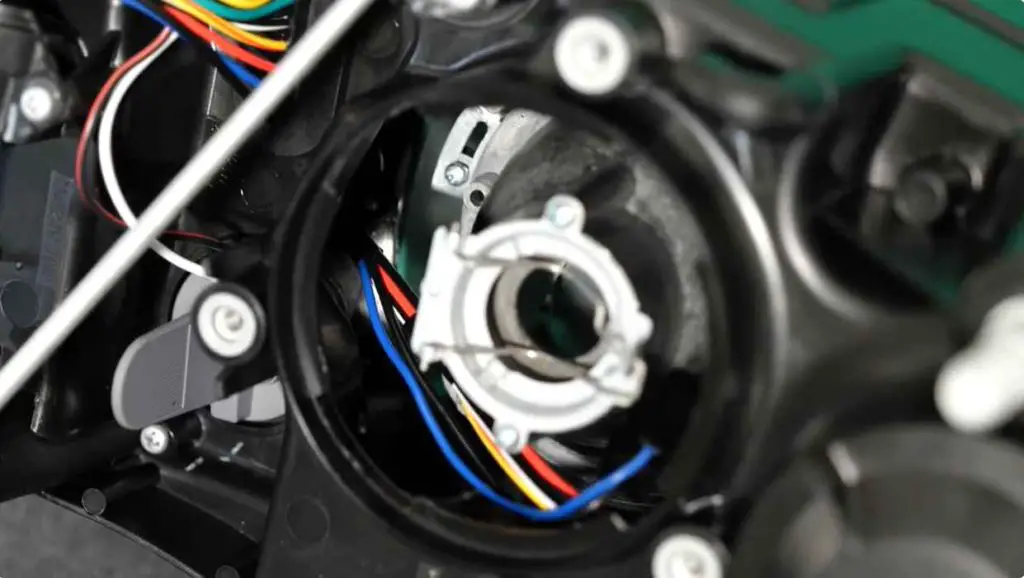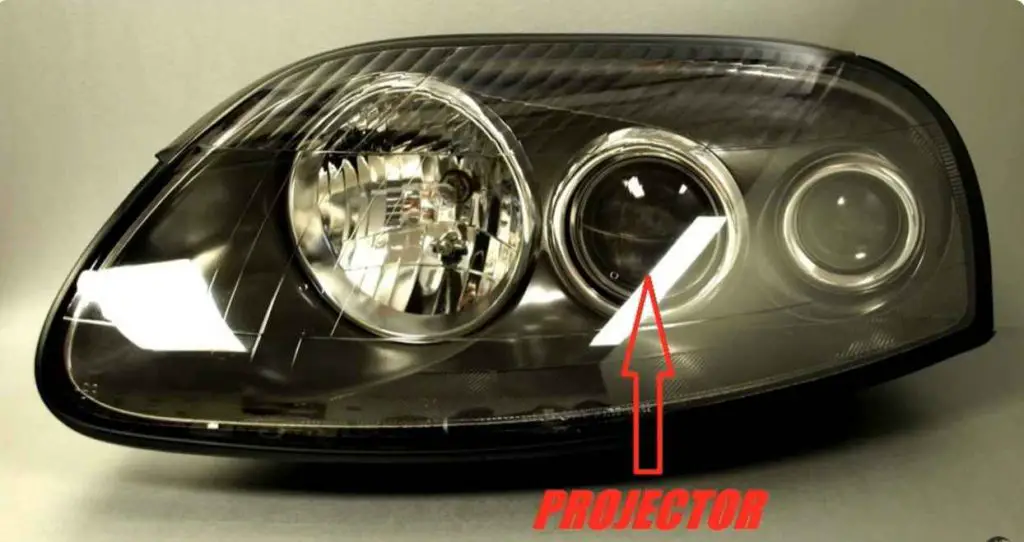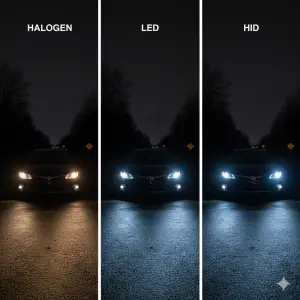LHD (Left-Hand Drive) and RHD (Right-Hand Drive) headlights are designed for vehicles based on the side of the road they primarily travel. The former suits countries driving on the right, while the latter is for left-side driving nations.
Headlights are a critical component of vehicle safety, guiding drivers through low visibility conditions while also ensuring they don’t blind oncoming traffic. Differences between LHD and RHD headlights are not merely cosmetic; they are engineered to align with distinct traffic patterns across various countries.
You want to know what is the difference between LHD and RHD headlights. instance, in the US, LHD headlights cast their beam downwards and to the right to accommodate right-side road driving, avoiding the eyes of oncoming drivers. Conversely, in the UK, RHD headlights tilt the beam downwards and to the left for the same reason.
This careful adjustment is vital for minimizing accidents and ensuring a safe driving experience. Such design variations in headlights help maintain proper road etiquette and visibility, adhering to the specific regulations of each country.
Introduction To Vehicle Headlight Orientation
Imagine driving at night and suddenly, your visibility dims. Headlights guide the way. Not all headlights are the same. Cars have different types: LHD and RHD. These terms confuse many, but not anymore. Let’s dive into what each means and why they matter.

Definition Of Lhd And Rhd Headlights
LHD (Left-Hand Drive) and RHD (Right-Hand Drive) headlights are designed based on where your car steers. LHD cars steer from the left, while RHD cars do from the right. The headlights match this setup to optimize visibility without blinding oncoming traffic.
- LHD Headlights: Aim higher on the right, and lower on the left.
- RHD Headlights: Aim higher on the left, and lower on the right.
The key is the traffic direction. In LHD countries, you drive on the road’s right side; in RHD ones, on the left. Headlights complement these rules. They keep roads safe and drivers see clear paths ahead.
Historical Context Of Driving Orientations
Horse-drawn carriages shape our road rules. Different countries chose different sides. This choice affects car designs today, including headlights. Headlights must align with local driving orientation. They evolved to fit safety standards worldwide.
| Country Type | Driving Side | Headlight Type |
|---|---|---|
| LHD Countries | Right Side | LHD Headlights |
| RHD Countries | Left Side | RHD Headlights |
In history, RHD was common in the UK and its colonies. LHD prevailed in the USA and Europe. Today, countries and territories around the globe follow their standards for safety and regulation. These standards ensure drivers have the correct headlight orientation for their vehicle’s steering position.
Functionality Of Headlights In LHD and RHD Vehicles
Mastering how headlights work in cars is important for safety. Two types of vehicles exist: Left-Hand Drive (LHD) and Right-Hand Drive (RHD). Each requires different headlights. This ensures the driver can see well and not blind others.
Beam Pattern And Focus
Headlights for LHD and RHD cars shine light differently.
- LHD headlights point light to the right side of the road.
- RHD headlights direct beams to the left side.
This design stops light from going into oncoming drivers’ eyes. Headlights must match your car type to avoid mistakes in light focus.
Impact On Visibility And Safety
The right headlights improve how well you see at night. They lower the risks of crashes. It’s illegal to drive with the wrong headlights. They can dazzle other drivers and cause accidents. Always use the correct headlights for your car’s design.

Design Differences Between LHD and Rhd Headlights
Comprehending the design differences between LHD and RHD headlights is vital for safe driving. LHD stands for Left-Hand Drive, used in countries where traffic moves to the right, while RHD stands for Right-Hand Drive, for places where traffic keeps to the left. The headlights in these vehicles differ to accommodate driving conditions and improve road safety.
Physical Structure Variations
Headlights are not universally interchangeable due to their structure. The beam patterns are distinct to prevent glare. Let’s delve into the physical structure differences:
- LHD headlights angle the light beam downwards and to the right.
- RHD headlights direct the beam downwards and to the left.
This ensures drivers do not blind oncoming traffic. It’s key to match the headlight type with your vehicle’s driving configuration.
Regulatory Compliance For Headlight Design
Headlight design must follow specific rules. Regulations differ across countries but aim to standardize safety. A breakdown of these regulations:
| Region | LHD Headlight Standards | RHD Headlight Standards |
|---|---|---|
| Europe | ECE regulations | ECE regulations |
| USA | FMVSS standards | N/A |
| Japan | N/A | JIS standards |
Manufacturers design headlights to meet these standards. Vehicles must have the correct headlights for their designated markets to ensure driver and pedestrian safety.
Global Distribution Of Lhd And Rhd Vehicles
When you drive across borders, you might notice a key difference in cars. It’s all about which side the steering wheel is on and how the headlights angle. Countries around the world are split into two major types of vehicle configurations: left-hand drive (LHD) and right-hand drive (RHD). This not only affects the driver’s position but also how headlights are adjusted to illuminate the road without blinding oncoming traffic. Let’s explore which countries fall under each category.
List Of Countries With LHD Vehicles
Most of the world drives on the right side of the road, and their vehicles are LHD. This means the driver’s seat and controls are on the left side of the car interior. Notably, the Americas, most of Europe, and large parts of Africa prefer LHD vehicles. Here’s a breakdown of different regions where LHD is common:
- North America: United States, Canada, Mexico
- South America: Brazil, Argentina, Colombia
- Europe: France, Germany, Spain
- Africa: Egypt, South Africa (though it drives on the left), Nigeria
List Of Countries With Rhd Vehicles
The RHD layout is typical for countries driving on the left side of the road. Found mainly in former British colonies, this configuration places the driver on the right. Key countries that follow the RHD system include:
- Asia: India, Japan, Thailand
- Europe: United Kingdom, Ireland, Malta
- Oceania: Australia, New Zealand
- Africa: Kenya, South Africa, Uganda

Legal Implications Of Using The Incorrect Headlight Type
Insighting the legal implications of using the incorrect headlight type is critical for any driver. Headlights designed for Right-Hand Drive (RHD) and Left-Hand Drive (LHD) vehicles differ in their beam patterns.
Using the wrong type can not only impair your vision but also affect oncoming traffic, posing safety risks and legal issues.
Safety Regulations And Legal Requirements
Countries enforce strict safety regulations regarding vehicle lighting. These rules ensure drivers have optimal visibility without blinding others.
The incorrect headlight type can lead to serious safety hazards.
For instance, RHD headlights in LHD regions may direct light into oncoming traffic’s eyes. Similarly, LHD headlights in RHD areas can reduce the driver’s visibility of road signs and pedestrians.
Legal requirements vary, but the alignment of headlight beams to specific standards is a common necessity. Standards like the ECE in Europe or the DOT in the United States dictate these specifications.
Non-compliant vehicles can fail safety inspections, resulting in legal actions.
Penalties For Non-compliance
- Fines: Monetary penalties are the most common consequence for non-compliance with headlight regulations.
- Points on License: Points may accumulate on your driving record, potentially leading to license suspension.
- Re-testing: Vehicles may be subjected to re-testing and forced off the road until compliant.
- Insurance Issues: Insurance may be invalidated if an accident occurs due to incorrect headlight usage.
Ensuring compliance is vital for safety and avoiding legal repercussions. Regular checks and maintenance are advisable.
If traveling abroad, conversion kits or temporary adjustments are essential strategies for drivers.
Conversion Challenges From Lhd To Rhd And Vice Versa
Switching cars between countries can be tricky, especially when it comes to headlights. Cars in countries that drive on the left side of the road (LHD) have different headlight orientations than those in countries that drive on the right side (RHD). This mismatch can cause visibility issues and even legal problems. Mastering the conversion challenges is essential for a safe and compliant vehicle transition.
Technical Considerations For Headlight Conversion
Headlights are designed to illuminate the road without blinding oncoming drivers. This means LHD and RHD headlights point light beams differently. Converting them isn’t just a matter of switching sides but involves precise adjustments:
- Beam Pattern: Changing the beam direction to avoid dazzling other drivers.
- Reflector Shape: Adjusting or replacing to cater to different road orientations.
- Leveling Controls: Ensuring headlights can be angled correctly post-conversion.
Cost Implications Of Converting Headlights
Headlight conversion costs can be significant, ranging from a few hundred to thousands of dollars. These can include:
| Cost Factor | Approximate Expense |
|---|---|
| New Headlight Units | $200 – $1000+ |
| Installation Labor | $50 – $200 |
| Adjustment Tools | $20 – $100 |
| Certification | Varies by region |
It’s vital to consider both parts and labor, plus potential inspection fees to ensure that the conversion meets local standards. Some regions also require certification from a professional, leading to an additional cost.

Manufacturing And Aftermarket Headlight Options For Lhd/rhd
Comprehending the intricacies of vehicle headlights is critical for optimal driving and compliance with regional regulations. Vehicles are equipped with specific headlight types based on whether they are meant for Left-Hand Drive (LHD) or Right-Hand Drive (RHD) traffic systems. In the fascinating world of headlight manufacturing and aftermarket options, car owners must navigate through choices to ensure they select suitable replacements or upgrades for their vehicles, whether they are driving in LHD or RHD regions.
Original Equipment Manufacturer (OEM) Vs. Aftermarket Headlights
Headlights come from two main sources: OEM and aftermarket suppliers. OEM headlights are made by the vehicle’s original maker. They match factory specifications and ensure consistent quality and fitment. Aftermarket headlights are produced by third-party companies. They often offer more variety and competitive pricing, along with unique designs and features not found in OEM parts.
Availability And Selection Of Headlights In Different Markets
Diverse markets worldwide dictate headlight availability. In countries with LHD vehicles, headlights are designed to illuminate more on the right side of the road. Conversely, RHD vehicle headlights focus more light on the left side. This is to prevent blinding oncoming traffic depending on the driving lane. Availability will vary with certain headlights being easier to find in specific markets. For instance:
- RHD countries: Stocking predominantly RHD-compatible headlights.
- LHD countries: Maintaining a broader range of LHD headlight options.
Aftermarket suppliers play a essential role in providing a wider selection. Customization and regional compliance can be easier with their various offerings. When seeking headlights, it’s essential to ensure that the choices align with local standards and fit the vehicle properly.
Technological Advancements In Headlight Systems
The automotive world constantly evolves, and nowhere is this more evident than in the area of vehicle headlight technology. Once simple beams of light, headlight systems now encompass high-tech components that vie to improve road safety and driver visibility. LHD (Left Hand Drive) and RHD (Right Hand Drive) vehicles not only differ in steering wheel position but also their headlight orientation, tailored to suit the driving rules of different countries. Modern advancements have significantly impacted how these systems operate, particularly with the advent of adaptive technologies and the introduction of LED and laser lights.
Adaptive Headlight Technologies
The introduction of adaptive headlight technologies has redefined night-time driving. These systems intuitively adjust the headlight beam direction based on vehicle speed, steering wheel movement, and elevation changes. This technology ensures that the light beam always points where the driver intends to go, subsequently improving safety for all road users.
- Curves in the road prompt the headlight beams to swivel, illuminating the road ahead, around bends.
- When a vehicle ascends or descends hills, the adaptive system levels the beams to maintain optimal road coverage.
- Speed-sensitive features alter beam intensity; higher speeds cast beams further ahead.
Impact Of LED and Laser Lights On Lhd/rhd Configurations
The incorporation of LED (Light Emitting Diode) and laser lights in headlight design has had a telling impact on both LHD and RHD configurations. These light systems are energy-efficient, offer longer life spans, and provide brighter lighting compared to traditional halogen bulbs.
| Feature | LED Headlights | Laser Headlights |
|---|---|---|
| Energy Consumption | Low | Very Low |
| Brightness | High | Extremely High |
| Lifespan | Long | Longer |
LED and laser systems accommodate the directional requirements of LHD and RHD headlights, featuring precise control mechanisms to adapt light patterns accordingly. They ensure that the light beam avoids blinding oncoming drivers while providing the best possible road illumination. This technological leap forward represents a huge stride in vehicle safety and driver comfort.
Importance Of Correct Headlight Adjustment
Driving at night or in bad weather needs clear visibility. Your car’s headlights play a critical role. Properly adjusted headlights ensure you can see the road. They also prevent blinding other drivers. The difference between Left-Hand Drive (LHD) and Right-Hand Drive (RHD) vehicles includes the headlight beam pattern. Correct headlight adjustment corresponds to the side of the road each vehicle drives on. Wrong adjustments may lead to accidents or fines.
Headlight Alignment For Optimal Performance
Headlight alignment is key for safety. It affects how far and wide the light shines. Proper alignment helps to spot obstacles and road signs. Misalignment can cause poor visibility. It can also dazzle oncoming traffic.
Follow these steps for the right alignment:
- Check your vehicle’s manual for specified requirements.
- Park on a level surface facing a wall or garage door.
- Use the adjustment screws to align the beams correctly.
- Test your alignment in real driving conditions.
Diy Adjustments Vs. Professional Services
Headlight adjustment can be a DIY task, but professional services have benefits. Doing it yourself can save money. Yet, without the right tools, you may not get it perfect.
| DIY Adjustments | Professional Services |
|---|---|
| Cost-effective | Accurate equipment |
| Step-by-step guides available | Expertise and experience |
| Can be done at home | Time-saving |
Mechanics use calibrated machines for precise adjustments. They understand the requirements for both LHD and RHD cars. Therefore, heading to a professional may be your best choice.

Traveling Internationally With Lhd/rhd Vehicles
Imagine crossing borders in your car only to realize that the headlights aren’t suited for the new roads. This issue is common when driving Left-hand Drive (LHD) cars in Right-hand Drive (RHD) countries, or vice versa. Knowing the differences and solutions is essential for international travelers.
Challenges Of Driving A Non-native Vehicle Overseas
Driving a vehicle that’s not configured for the hosting country can be tricky. LHD vehicles have headlights angled for right-lane driving. This can blind oncoming traffic in RHD countries. Similarly, RHD vehicles can cause the same problem in LHD countries.
- Potential fines for improper headlamp alignment
- Increased risk of accidents due to poor visibility
- Difficulty adapting to new road rules and signs
Temporary Headlight Adjustments For International Travel
Before embarking on your journey, make the necessary temporary changes to your headlights. This helps avoid penalties and ensures safety.
- Consult your vehicle’s manual for headlight adjustment procedures
- Use adhesive headlamp beam converters to redirect the light
- Visit a local mechanic to adjust the beams professionally if needed
Remember, safety comes first! Be well-prepared to tackle the unique challenges of international road travel with your LHD or RHD vehicle.
Conversion Challenges From Lhd To Rhd And Vice Versa
Insighting how left-hand drive (LHD) and right-hand drive (RHD) vehicles use different headlights is important for safety. The angle of the light beam must match the direction of traffic. This is where headlight converters play a key role for drivers moving between countries that use different driving systems.
How Headlight Converters Work
Headlight converters are essential for adjusting the direction of a vehicle’s headlight beam. In LHD countries, headlights are designed to veer slightly right. In RHD countries, it’s the opposite.
Converters re-direct the beam to prevent dazzling oncoming drivers. They attach to your vehicle’s headlights and modify the beam pattern. This allows drivers in both LHD and RHD regions to drive safely and legally.
The Viability Of Temporary Headlight Conversion Kits
Temporary headlight conversion kits offer a quick fix for travelers. These kits involve adhesive deflectors or stickers applied to the headlight lens.
- Easy to apply: No tools required
- Cost-effective: Cheaper than permanent modifications
- Ideal for short trips: Perfect for holiday-goers or short business trips
While they’re convenient, they’re not a permanent solution. In the long term, drivers should consider professional conversion for continual compliance and optimum safety.
Conclusion: Harmonizing Lhd And Rhd Headlight Standards
The world of automotive lighting stands at a crossroads, where Left-Hand Drive (LHD) and Right-Hand Drive (RHD) standards differ. The harmonization of LHD and RHD headlight standards aims to simplify global manufacturing. It ensures compatibility and safety across borders. Let’s explore how this unification can impact road users worldwide.
The Future Of Global Headlight Standards
The automotive industry recognizes the need for common headlight standards. It works to ease international trade and vehicle use. A future where headlights conform to unified regulations promises to reduce production costs. It simplifies design for car makers. This shift supports innovation in lighting technology. It caters to a diverse range of driving conditions.
The Significance Of Unified Standards For Road Safety
Unified standards for LHD and RHD headlights serve a critical role. They enhance safety on the roads. With consistent lighting patterns, drivers face less confusion. They adapt more easily to different traffic systems. “Dazzle” effects reduce, lowering the chances of accidents. Uniform headlight standards pave the way for better illumination and clearer visibility. Such improvements are essential for every road user’s safety.
Frequently Asked Questions On What Is The Difference Between LHD and Rhd Headlights
How Do I Know If My Headlights Are Rhd Or Lhd?
Check your vehicle’s documentation or look for a sticker on the headlight assembly indicating ‘RHD’ (Right-Hand Drive) or ‘LHD’ (Left-Hand Drive). The beam pattern also differs; RHD points to the left, and LHD to the right.
Can You Fit Lhd Headlights To Rhd?
It’s possible to fit LHD headlights to a RHD car, but it’s not advisable due to safety and legal concerns. The beam patterns differ, potentially causing visibility issues and blinding oncoming traffic. Always opt for country-specific headlights for road safety compliance.
Are Left And Right Headlights The Same?
Left and right headlights are not always the same. Differences in their assembly and lens pattern often make them vehicle-side specific.
What Are LHD Headlights?
LHD headlights are designed for vehicles that drive on the right side of the road, providing optimal illumination while minimizing glare for oncoming traffic. They are standard in countries with left-hand drive vehicles.



